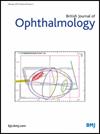The eye as a window to oral and pain symptoms in Sjögren’s disease
IF 3.5
2区 医学
Q1 OPHTHALMOLOGY
引用次数: 0
Abstract
Background To investigate whether certain dry eye (DE) metrics relate to oral and pain manifestations of Sjögren’s disease (SjD). Methods Secondary analysis of the Sjögren’s International Collaborative Clinical Alliance dataset containing 1541 individuals with 2016 American College of Rheumatology/European League Against Rheumatism defined SjD. Binary logistic regression analyses examined which of 13 DE features related to various extraocular metrics. Results The mean age of the population was 52±13.5 years; 45% identified as white and 94% as women. Heterogeneity in DE symptoms and signs was noted in individuals with SjD, with approximately one-third of individuals reporting significant spontaneous and/or evoked pain using various descriptors and indicating certain triggers, and approximately half having low tear production. Similarly, heterogeneity was noted with respect to oral and pain complaints, with extraocular pain symptoms found in approximately one-third of the population. Different ocular phenotypes aligned with different extraocular findings. Specifically, grittiness or scratchiness in the eyes (OR=1.6), blurred vision (OR=1.4) and low tear production (OR=1.8) most closely aligned with oral dryness (‘Does your mouth feel dry?). On the other hand, burning or stinging in the eyes (OR=1.6), discomfort in low humidity (OR=1.2) and the absence of DE signs (normal tear production, OR=0.7; lack of ocular surface staining, OR=0.6) most closely aligned with pain outside the eye (‘Do you experience persistent or frequent burning discomfort?’). Conclusions Our findings suggest heterogeneity in SjD ocular presentations that predict extraocular features of disease and hint at mechanisms that underlie heterogeneity, namely divergent neurosensory processes. Data are available upon reasonable request. See above.眼睛是了解斯约格伦病口腔和疼痛症状的窗口
研究干眼(DE)指标是否与Sjögren病(SjD)的口腔和疼痛表现相关。方法对Sjögren的国际协作临床联盟数据集进行二次分析,该数据集包含1541名2016年美国风湿病学会/欧洲抗风湿病联盟定义的SjD患者。二元逻辑回归分析检验了13个DE特征中哪一个与各种眼外指标相关。结果人群平均年龄为52±13.5岁;45%为白人,94%为女性。在SjD患者中,DE症状和体征存在异质性,大约三分之一的患者使用各种描述符和某些触发因素报告明显的自发性和/或诱发性疼痛,大约一半的患者泪液分泌量低。同样,在口腔和疼痛主诉方面也存在异质性,大约三分之一的人群出现眼外疼痛症状。不同的眼表型与不同的眼外发现相一致。具体来说,眼睛磨砂或发痒(or =1.6)、视力模糊(or =1.4)和眼泪分泌少(or =1.8)与口腔干燥(“你的嘴巴感到干燥吗?”)最密切相关。另一方面,眼睛灼烧或刺痛(or =1.6),低湿度不适(or =1.2)和无DE体征(正常泪液分泌,or =0.7;眼表无染色,OR=0.6)与眼外疼痛最密切相关(“您是否感到持续或频繁的灼烧性不适?”)。结论:我们的研究结果表明SjD眼部表现的异质性可以预测疾病的眼外特征,并提示异质性背后的机制,即神经感觉过程的分化。如有合理要求,可提供资料。见上图。
本文章由计算机程序翻译,如有差异,请以英文原文为准。
求助全文
约1分钟内获得全文
求助全文
来源期刊
CiteScore
10.30
自引率
2.40%
发文量
213
审稿时长
3-6 weeks
期刊介绍:
The British Journal of Ophthalmology (BJO) is an international peer-reviewed journal for ophthalmologists and visual science specialists. BJO publishes clinical investigations, clinical observations, and clinically relevant laboratory investigations related to ophthalmology. It also provides major reviews and also publishes manuscripts covering regional issues in a global context.

 求助内容:
求助内容: 应助结果提醒方式:
应助结果提醒方式:


